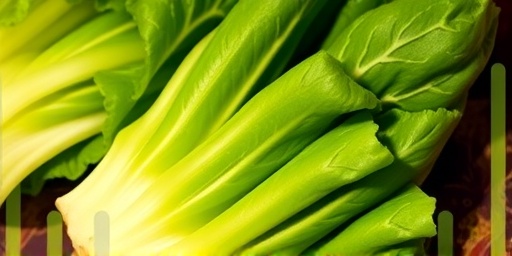Washington, D.C. – A rapidly spreading E. coli outbreak linked to contaminated romaine lettuce has sickened at least 50 people across 10 states, prompting urgent warnings from the FDA and CDC. Five individuals have been hospitalized, with health officials advising consumers to throw out all romaine products regardless of packaging or source.
The CDC reported the illnesses began as early as mid-September, with cases confirmed in California, New York, Texas, Florida, Illinois, Pennsylvania, Ohio, Michigan, Washington, and Georgia. Symptoms include severe abdominal cramps, diarrhea – often bloody – vomiting, and fever, typically appearing 3 to 4 days after consumption. Vulnerable groups like young children, the elderly, and those with weakened immune systems face the highest risks of complications such as hemolytic uremic syndrome (HUS), a life-threatening condition that can lead to kidney failure.
“This outbreak is a stark reminder of the dangers lurking in our food supply,” said Dr. Elena Ramirez, a food safety epidemiologist at the CDC. “We’ve identified romaine lettuce as the common source through whole genome sequencing of bacterial samples from patients.”
Illness Surge Hits Multiple States with Hospitalizations Rising
The E. coli outbreak has escalated quickly, with the CDC noting 50 confirmed cases as of the latest update. California leads with 12 illnesses, followed by New York (8) and Texas (7). Other affected states include Florida (6), Illinois (5), Pennsylvania (4), Ohio (3), Michigan (2), Washington (2), and Georgia (1). Demographically, 60% of victims are women, and ages range from 2 to 87 years old.
Hospitalizations stand at five, primarily among children under 10 and adults over 65. No deaths have been reported yet, but officials are monitoring closely. “The hospitalization rate is concerning,” stated FDA Commissioner Robert Califf in a press briefing. “This strain, identified as E. coli O157:H7, is particularly virulent and matches isolates from previous romaine lettuce incidents.”
Traceback investigations by the FDA point to romaine grown in the Salinas Valley region of California, a major lettuce-producing area. While no single farm has been pinpointed, multiple suppliers have voluntarily recalled products shipped between September 1 and October 15.
- Key Stats:
- 50 confirmed illnesses
- 5 hospitalizations (10% rate)
- 10 states affected
- Illness onset: September 15 – October 20
- Strain: Shiga toxin-producing E. coli (STEC) O157:H7
FDA and CDC Launch Coordinated Recall and Traceback Efforts
In a joint advisory, the FDA and CDC have urged consumers, restaurants, and retailers to discard all types of romaine lettuce, including hearts, whole heads, and salad mixes. “Do not buy, serve, or sell it,” the agencies stated emphatically. The recall covers products with no traceable source due to the widespread contamination risk.
The FDA‘s traceback has involved interviewing patients, reviewing purchase records, and inspecting supply chains. Preliminary findings link the outbreak to romaine harvested from Salinas Valley fields irrigated with potentially contaminated water. “We’re working around the clock with growers and distributors,” said FDA spokesperson Sarah Thompson. “Enhanced sampling and testing are underway to contain this.”
Industry response has been swift. Taylor Farms, a major Salinas-based supplier, issued a voluntary recall of romaine products distributed to 15 states. Other companies like Fresh Express and Dole followed suit, pulling thousands of cases from shelves. Grocery chains such as Whole Foods, Kroger, and Publix have posted signage and removed all romaine lettuce displays.
Traceback Timeline Highlights Rapid Response
- Sept 20: First cluster detected in California
- Oct 5: CDC activates outbreak team
- Oct 10: Romaine lettuce identified as vehicle
- Oct 15: Multi-state advisory issued
- Oct 18: Recalls begin, consumer alert peaks
Symptoms and Health Impacts of Deadly E. Coli Strain Exposed
E. coli O157:H7, the culprit in this outbreak, produces Shiga toxins that damage blood vessels in the intestines and kidneys. Initial symptoms mimic food poisoning but can worsen dramatically. Most recover within a week, but 5-10% develop HUS, requiring dialysis or worse.
Dr. Marcus Hale, an infectious disease specialist at Johns Hopkins, explained: “Romaine lettuce is prone to contamination because it’s eaten raw, and fields near cattle operations can spread bacteria via irrigation water, wildlife, or manure. Cooking kills it, but salads don’t.” Past victims describe agony: “It felt like my stomach was exploding,” shared one anonymous patient from Texas.
The CDC estimates underreporting, as mild cases often go untested. Public health labs have sequenced 32 patient samples, all matching the outbreak strain, confirming the romaine lettuce link with 100% specificity.
Long-term effects include chronic kidney disease, hypertension, and neurological issues. In 2018, a similar E. coli outbreak from romaine hospitalized 78 and killed five, underscoring the stakes.
Past Romaine Recalls Haunt Industry Amid Calls for Reform
This isn’t the first time romaine lettuce has triggered alarm. The 2018 Yuma, Arizona outbreak sickened 210 nationwide, hospitalizing 96. In 2019, another Salinas Valley incident affected 17 states. Both led to blanket recalls costing the industry $100-300 million each.
“We’ve seen this movie before,” said Tom Stenzel, former CEO of the United Fresh Produce Association. “Water quality, worker hygiene, and wildlife management are chronic issues. The Leafy Greens Marketing Agreement needs teeth.”
The FDA has since implemented the Produce Safety Rule under FSMA, mandating safer farming practices. Yet critics argue enforcement lags. Consumer advocates like Food & Water Watch demand year-round traceability tech like blockchain.
Economic ripple effects are massive: Romaine prices have spiked 50%, and exports to Canada halted. California growers, who supply 70% of U.S. lettuce, face scrutiny over irrigation from the Salinas River, potentially fecal-contaminated.
Consumer Protection Steps and Ongoing Investigation Outlook
To stay safe, the CDC and FDA recommend washing hands thoroughly, cooking greens if unsure, and checking cdc.gov/ecoli for updates. Restaurants should switch to alternatives like kale or spinach.
Looking ahead, investigators aim to identify the exact contamination source within weeks, potentially leading to farm shutdowns or fines. Enhanced surveillance, including wastewater testing near fields, is ramping up. “We’re not stopping until every risk is mitigated,” vowed CDC Director Rochelle Walensky.
Public health experts predict more cases before the outbreak peaks, urging vigilance through winter salads. As Thanksgiving approaches, officials eye supply chains for holiday disruptions. Growers pledge better practices, but consumers remain the first line of defense – inspect, avoid, report.
For the latest, visit FDA and CDC outbreak pages. If symptoms appear post-romaine consumption, seek medical care and notify local health departments.









